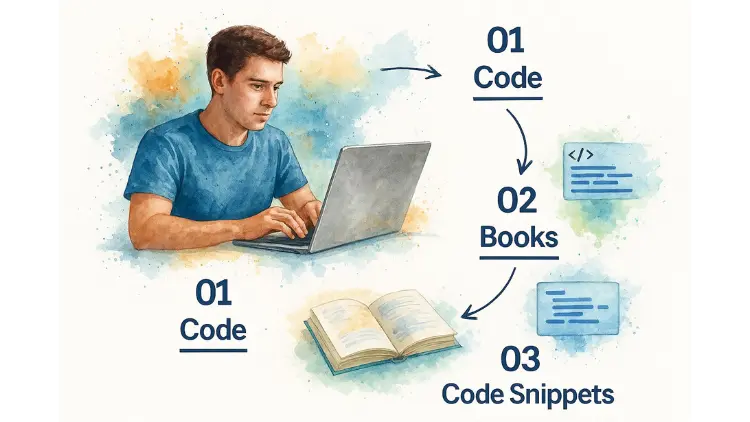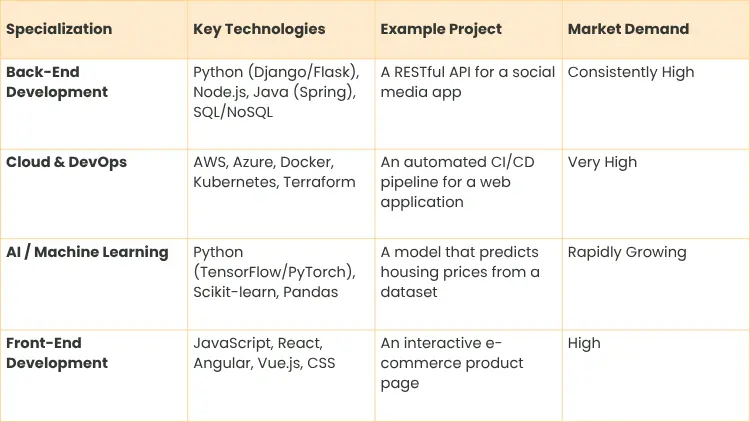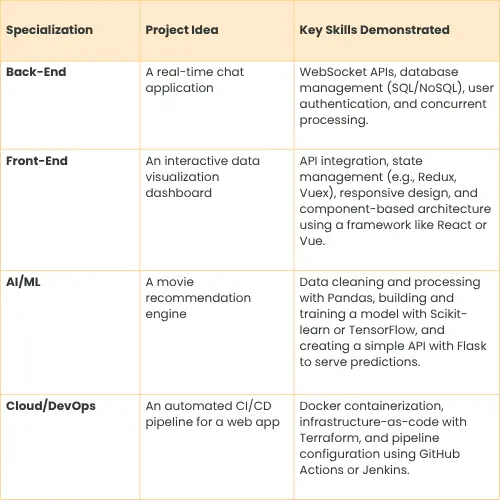How to Get a Software Engineering Job This Year

To land a software engineering job today, you need a strategy that actually works in this market. It boils down to three things: focus on in-demand skills, build a portfolio with 2-3 killer projects, and network like your career depends on it (because it does).
This approach helps you bypass the crowded front door of online applications and gets you directly to the interview stage.
Jump To Section

Earn As You Learn
Earn 25% commission when your network purchase Uplyrn courses or subscribe to our annual membership. It’s the best thing ever. Next to learning,
of course.
Navigating the Modern Tech Job Market
Before you even think about bootcamps or tweaking your resume, you need a clear picture of the current software engineering landscape. It’s a different world than it was a few years ago. The days of hyper-growth and rapid-fire hiring are gone, replaced by a more deliberate, skills-first mindset.
Companies aren't just looking for bodies to fill seats anymore. They’re on the hunt for specialists who can jump in and solve specific, high-value problems from day one. This means your job search has to be way more targeted. Forget shotgunning your resume to hundreds of generic "Software Engineer" roles—the real goal is to find niches where the demand for talent is high and the supply is low.
The New Pockets of Opportunity
While the headlines are full of layoff news from Big Tech, tons of other industries are quietly ramping up their tech hiring. In fact, some of the best opportunities right now are far from the traditional Silicon Valley scene.
- Non-Tech Industries: Look at sectors like finance, healthcare, and retail. They are pouring money into their digital infrastructure. They need engineers to build everything from secure banking apps and patient data systems to slick e-commerce platforms. These jobs often come with more stability and a completely different set of fascinating challenges.
- High-Growth Specializations: Fields like Artificial Intelligence, cloud infrastructure, and cybersecurity aren't just buzzwords—they are the most resilient areas for job growth, period. Companies are practically desperate for engineers who can build and maintain AI models or lock down their cloud environments.
Understanding these trends is your first move. The market has definitely cooled off from the hiring frenzy of 2021-2022, settling into a more selective environment. While overall software developer job postings have dipped by about 35% from their peak five years ago, that number is misleading.
The U.S. Bureau of Labor Statistics still projects a massive 17% growth for software development roles through 2033, which works out to about 327,900 new jobs. The kicker? That growth is almost entirely driven by demand in AI and machine learning, where roles are expanding more than three times faster than the average job. That’s where the momentum is.
A Deliberate, Skills-First Approach
In this new climate, what you can do matters more than where you went to school. A computer science degree is great, but a portfolio that shows you can build a full-stack application with a modern framework is often what gets you the interview.
This shift has created a noticeable skills gap in the workforce. Companies are struggling to find people with the specific, practical abilities they need right now. This market correction is a huge advantage for anyone who is prepared and specialized.
Actionable Insight: Don't just learn to code; learn to solve business problems with code. For example, instead of just building a generic "to-do list app", build a project management tool for a niche you understand, like freelance writers. This demonstrates not just technical skill but also product thinking, which is a huge plus for employers.
As you get into the job hunt, knowing how to build your personal brand is a massive differentiator. Your brand is the story you tell through your projects, your GitHub, your LinkedIn, and every professional conversation you have. It’s what makes you memorable in a sea of applicants, clearly communicating your expertise and passion before you even walk in the door.
Building Skills That Get You Hired
Before you can even think about landing a top-tier software engineering job, you need a toolkit that companies are actually looking for. A solid technical foundation isn’t just about knowing concepts; it's about proving you can build real-world solutions. This means starting with the fundamentals and then quickly picking a specialty that makes you a high-value hire.
The hiring landscape has definitely shifted. A recent analysis shows that even with all the talk about tech layoffs, specialized roles are hotter than ever. In 2023, over 264,000 tech employees were laid off, with another 152,000 following in 2024. But these weren't random cuts. Companies were reorganizing to double down on efficiency and innovation—especially in AI.
While generalist roles took a hit, giants like Bank of America and Chase actually ramped up their hiring for engineers in AI, cybersecurity, and cloud infrastructure. For anyone figuring out how to get a software engineering job, the signal is crystal clear: specialization is your ticket in. You can get a deeper look into these market trends in this 2025 tech hiring outlook.
This visual guide breaks down the skill-building process, from mastering the basics to choosing a high-demand specialization.
As you can see, it's a clear path from foundational knowledge to applied expertise, with a heavy emphasis on building tangible projects all along the way.

Start with a Strong Foundation
Every great software engineer, no matter their specialty, stands on the same solid ground of core concepts. Think of these as the basic grammar of programming—without them, you can't build anything meaningful.
Here’s where you absolutely must start:
- One or Two Core Languages: Don't spread yourself thin trying to learn ten languages at once. Pick one versatile language like Python for its clean syntax and massive role in AI and back-end systems, or JavaScript because of its total dominance in web development.
- Data Structures and Algorithms (DSA): This is completely non-negotiable. You have to understand how things like arrays, linked lists, hash tables, and trees work. They are the bedrock of efficient code and the main event in most technical interviews.
- Version Control with Git: Knowing your way around Git and platforms like GitHub is a baseline expectation. It proves you can work with a team in a professional setting.
If you're starting from square one, this guide on how to start coding for beginners is the perfect place to build that initial momentum.
Choose a High-Impact Specialization
Once the basics feel comfortable, it's time to pick a lane. Generalists often get lost in the noise of a competitive market, but specialists get hired. The goal here is to go deep in one area and become the go-to person for a specific type of problem.
Actionable Insight: Don't just follow the hype. Choose a specialization that genuinely interests you but also has strong market demand. Your passion will fuel your learning, and the demand will get you paid. A practical way to do this is to browse job descriptions for roles that sound exciting and identify the most frequently mentioned technologies. This ensures your learning path is aligned with real-world needs.
To help you decide, let's break down some of the most in-demand fields right now.
Choosing Your Software Engineering Specialization
Picking a path can feel overwhelming, but looking at the technologies, project types, and job demand can bring a lot of clarity. This table compares some of the most popular specializations to help you find the best fit.
Ultimately, your choice should be a mix of what excites you and what the market values. Any of these paths can lead to a fantastic career if you commit to mastering the craft.

Turn Knowledge into Tangible Skills
Let’s be real: reading documentation and finishing tutorials is just the beginning. To truly prove you have what it takes, you have to build things. This is easily the most important part of the entire learning process.
For instance, if you settle on back-end development, don't just learn the syntax of Python and Django. Go build a complete project, like a blog engine with user authentication and a real database. This is what forces you to solve actual problems, hunt down bugs, and finally understand how all the different pieces fit together.
This is the hands-on experience that will fill your portfolio and give you compelling stories to share during your interviews.
Crafting a Resume and Portfolio That Actually Gets Noticed
Let's be honest: your resume and portfolio are the one-two punch that gets you through the door. A hiring manager might only give your resume six seconds of their time. That’s it. So every single word, every project you choose, has to count. Think of these documents less as a history report and more as your personal marketing materials, designed to make a killer first impression.
The biggest mistake we see people make is creating one "perfect" resume and carpet-bombing every job opening with it. The real pro move? Have a master resume that you tweak for every single job application. This small bit of effort shows you’ve done your homework and are genuinely interested in their problems, not just finding any old software engineering job.
Build a Resume That Screams "Impact"
Most resumes are, frankly, a bit of a snooze fest. They list duties like, "Wrote code for the user authentication system". Okay, great. That tells a recruiter what you did, but it says nothing about how well you did it or why anyone should care. To stand out, you have to frame your accomplishments in terms of the results they produced.
The secret sauce here is the STAR method (Situation, Task, Action, Result). It’s a simple framework that forces you to think about outcomes, which is exactly what hiring managers are scanning for.
- Weak Bullet Point: "Responsible for front-end development using React."
- Strong Bullet Point: "Led the redesign of the main dashboard using React, resulting in a 40% decrease in user-reported bugs and a 15% improvement in page load times."
See the difference? The second one is infinitely more powerful. It showcases your technical skill (React), hints at leadership (Led the redesign), and, most importantly, provides hard numbers on the business impact. You've just turned a boring task into a compelling success story. For an even deeper dive, this guide on how to write a resume has some great templates and examples.
Curate a Portfolio That Proves You Can Build Things
Your portfolio is where the rubber meets the road. It’s the tangible proof that you can actually ship code. A common rookie mistake is to cram it full of dozens of tiny, half-baked projects from online tutorials. That doesn't impress anyone.
Instead, go for quality over quantity.
Aim for 2-3 high-impact, polished projects that demonstrate a diverse range of skills. A portfolio with a complex full-stack application, a data processing pipeline, and a mobile-responsive front-end project is far more powerful than ten half-finished to-do list apps.
Treat each project in your portfolio like a mini case study of your problem-solving chops. Don’t just throw a link to a GitHub repo on your resume and call it a day.
- Write a Killer README: Your project's README is its landing page. Clearly explain what the project does, the problem it solves, and the tech stack you used. Don't forget setup instructions and—this is crucial—screenshots or a GIF of your project in action.
- Deploy Live Demos: If you do one thing, do this. Host your projects and provide a link to a live demo. It’s the single most effective way to get a recruiter or hiring manager to engage with your work. It removes all the friction and lets them see what you can do instantly.
- Show Off Your Clean Code: Your GitHub profile is basically an extension of your resume. Make sure your code is well-commented, your commit history is clean and descriptive, and your repos are neatly organized. This signals professionalism and a real attention to detail.
If you're looking for more guidance on putting all your application materials together, check out this complete guide to writing a job application resume.
Practical Examples of High-Impact Projects
Stuck on what to build? Here are a few ideas for different specializations that are almost guaranteed to catch a hiring manager's eye.
Ultimately, choosing projects that genuinely challenge you and line up with the kinds of roles you want is a huge step. These projects will become the core talking points in your interviews, giving you concrete evidence of your skills and passion for the craft.

Executing a Smarter Job Search
Alright, you've got a polished resume and a portfolio that shows off your skills. Time to start the hunt. But hold on—the biggest mistake we see aspiring engineers make is falling into the "apply to everything" trap.
Mindlessly smashing the 'Apply' button on job boards is a direct path to burnout and frustration. A smarter, more targeted approach is what separates the candidates who get interviews from those who just get automated rejection emails.
This means you need to shift your mindset from a volume game to a quality game. Instead of just blasting your application into the void, you're going to focus on identifying the right companies, understanding the job market's geography, and building real connections that turn into warm introductions.
Target Companies, Not Just Job Postings
Your first move should be to build a curated list of companies you genuinely want to work for. Seriously, take a moment and think about what actually matters to you. Is it the company's mission? Its tech stack? The culture? Maybe it's their commitment to fully remote work.
Fire up a spreadsheet and start tracking 20-30 target companies.
This simple step immediately puts you in a proactive position. You can follow their company pages on LinkedIn, engage with their content, and keep an eye out for openings before they even hit the major job boards. It’s a world away from just reacting to whatever an algorithm shows you today. This guide on optimizing your online job portal profile can also help make sure recruiters from these specific companies can find you.
Where you look is also changing. The traditional U.S. tech hubs like California and Texas are still massive, with California posting around 11,000 software engineering jobs and Texas around 8,000 in a recent month.
But the ground is shifting. California actually saw an 18% hiring decline, and Washington state dropped by 23%. At the same time, some unexpected states are booming: Hawaii (+32%), South Dakota (+17%), and Tennessee (+14%) all saw significant growth. This is often driven by companies looking for remote talent and local incentives. Keeping an eye on these emerging markets opens up a whole new set of opportunities. You can discover more insights about these software engineering job trends to stay ahead of the curve.
Networking That Feels Genuine
Networking gets a bad rap. Most people think it’s about schmoozing or awkwardly asking for favors. It's not. It's about building real relationships based on shared interests and mutual value.
Here's a statistic that should get your attention: a referral from an employee inside a company can increase your chance of landing an interview by as much as 10x compared to a cold application. That's the power of a real connection.
Here are a few practical ways to build your network without feeling slimy:
- Jump into Online Tech Communities: Find active communities on platforms like Discord, Slack, or Reddit that are focused on your specialty. Don't just lurk—answer questions, share what you're learning, and actually participate in the conversations. For example, join a Python-focused Discord and help someone debug a simple script.
- Contribute to Open Source: Find a small, beginner-friendly open-source project that uses a technology you're learning. Fixing a typo in the documentation or tackling a "good first issue" bug is a fantastic way to collaborate with other developers and get your name out there.
- Be Strategic on LinkedIn: Don't just send a blank connection request. When you find an engineer or recruiter at one of your target companies, send a personalized note. Mention a specific project of theirs you admire or ask a thoughtful question about their work.
Practical Example of a Connection Request: "Hi [Name], I'm a software engineer specializing in React and I was really impressed by the new dashboard you launched for [Company Name]. I'm particularly interested in how your team approached state management for such a complex UI. I'd love to connect and follow your work."
This simple, genuine approach shows you've done your homework and are interested in more than just getting a job. It opens the door for a real conversation, which is what effective networking is all about. This is how you transform your job search from a passive numbers game into an active, strategic campaign to land a role you’ll truly love.
Nailing the Technical and Behavioral Interviews
Alright, you've made it to the final: the interview process. This is where all your hard work—the coding, the projects, the networking—comes together. It's the moment that separates getting the offer from getting the "we'll keep your resume on file" email.
The whole thing usually kicks off with a quick chat with a recruiter. From there, you'll face one or more technical rounds, and it often wraps up with a behavioral or "team fit" interview. Each stage is designed to test something different, from your raw coding chops to how you'd mesh with the team.
Dominating the Technical Interview
The technical interview can feel like the most daunting part, but we promise, it's a skill you can build just like any other. The biggest secret? It’s not just about getting the "right" answer. It’s about showing them how you think.
Your ability to talk through your process is just as critical as the code you write. Interviewers want to see you break down a complex problem, weigh the pros and cons of different approaches, and clearly explain your logic. A candidate who silently types out a perfect solution is way less impressive than someone who communicates their thought process, even if they hit a few bumps along the way.
Here’s how you can get ready:
- Practice with purpose. Don't just mindlessly grind problems on platforms like LeetCode or HackerRank. Instead, focus on mastering common patterns like two-pointers, sliding windows, and graph traversals. Consistency is key here; 30-60 minutes a day beats a frantic eight-hour cram session on a Saturday.
- Think out loud. Every time you solve a practice problem, narrate your thoughts. For example, say "I'm choosing a hash map here because I need O(1) lookup time to check for duplicates, which is much faster than iterating through an array". This makes it second nature when you're in the hot seat.
- Run some mock interviews. Find a friend or use a platform like Pramp to simulate the real thing. It’s the best way to get comfortable with the time pressure and the act of coding while someone is watching.
If you're interviewing for a more senior position, get ready for system design questions. These are big, open-ended conversations where you'll be asked to design something like a news feed or a URL shortener. The goal isn't to produce a flawless diagram. It's to ask smart clarifying questions, spot potential bottlenecks, and discuss the trade-offs between different architectural decisions.
Mastering the Art of the Behavioral Interview
Once you’ve proven you have the technical skills, you need to show them you’re someone they’d actually want to work with. That’s what the behavioral interview is for. It’s all about gauging your soft skills: communication, teamwork, resilience, and how you solve problems with other people.
You'll hear a lot of questions that start with, "Tell me about a time when..." This is your cue to pull from your experiences—and your portfolio projects are a goldmine for these stories. Never just claim a skill; back it up with a concrete example from a project you actually built.
Actionable Insight: Don't just say, "I'm a good collaborator". Instead, talk about that specific time you and a project partner had a technical disagreement about using a NoSQL vs SQL database, what steps you took to map out the pros and cons for your specific use case, and how you collectively decided on the best path forward, which led to a better outcome.
Structure Your Answers with STAR
The STAR method is your best friend for crafting answers that are clear, concise, and compelling. It stands for Situation, Task, Action, and Result.
- Situation: Quickly set the scene. "On the e-commerce project I built, the product images were causing painfully slow load times."
- Task: State your objective. "My goal was to slash the page load speed to create a better user experience and reduce bounce rates."
- Action: Detail what you actually did. "I started by implementing lazy loading for all images, then I compressed the image files with a new library, and finally, I set up a CDN to cache them closer to our users."
- Result: Share the outcome with numbers. "These changes cut the initial page load time by 60% and we saw a 15% drop in the bounce rate on key product pages."
Using this structure transforms a simple task into a powerful story of impact. It shows you're not just a coder; you're a problem-solver who thinks about the business. For an even deeper dive into this crucial stage, check out this guide on interview skills that will get you hired.
By preparing thoughtfully for both the technical and behavioral sides of the interview, you'll walk in ready to prove you're the complete package.

Your Top Questions About Landing a SWE Job, Answered
Getting into software engineering can feel like navigating a maze, and it’s natural to have a ton of questions. What should my portfolio look like? Is my background good enough? How do I even start with system design? Let's clear up some of the most common questions we hear from aspiring engineers.
How Many Projects Should I Have in My Portfolio?
Forget the numbers game. The golden rule here is quality over quantity. Honestly, a portfolio with two or three polished, complex projects will impress a hiring manager way more than a dozen half-baked tutorials. Your real goal is to prove you can take an idea from a rough concept all the way to a finished product.
Think about showcasing a good mix of your abilities. You could build out something like:
- A full-stack web app that requires users to log in and interact with data. Practical Example: A recipe-sharing platform where users can post, rate, and save recipes.
- A script that pulls in messy data, cleans it up, and spits out some interesting analysis. Practical Example: A Python script that scrapes Reddit for mentions of a stock ticker and performs sentiment analysis.
- Something cool using a modern framework like React or a public API that you find interesting. Practical Example: A dashboard that uses the Spotify API to visualize a user's listening habits.
And for every single project, your GitHub repo needs to be immaculate. We're talking a crystal-clear README file, a link to a live demo (this is huge!), and clean, well-commented code that someone else can actually understand.
Your portfolio is more than just a code dump; it’s a curated showcase of how you solve problems. Every project should tell a story: "Here was the challenge I faced, and here's the clever solution I built."
Do I Really Need a Computer Science Degree to Get a Job?
While a CS degree is a great asset, it's absolutely not a hard requirement anymore. The industry has changed—a lot. Plenty of incredible engineers we know are bootcamp grads, self-taught coders, or transitioned from totally different STEM fields.
What hiring managers really care about is what you can build. Can you demonstrate your skills in a real-world way? If you have a killer portfolio, some contributions to open-source projects, and you can nail the technical interview, that practical experience often speaks louder than a specific degree on your resume.
I Have No Experience. How Can I Prepare for System Design Interviews?
This is a classic chicken-and-egg problem, but you can definitely crack it. You don't need years of on-the-job experience to ace a system design interview. What you do need is a solid framework for thinking and practicing.
First, get familiar with the fundamental building blocks. Dive into concepts like load balancing, caching strategies, API gateways, and the pros and cons of different database types. There are tons of mock interview videos online—watch them to get a feel for the back-and-forth communication style.
Then, it's time to get your hands dirty. Grab a whiteboard (or a diagramming tool like Excalidraw) and start designing systems you use every day. How would you build a URL shortener like bit.ly? What about the core of a Twitter feed or the basics of an Uber-like app? The trick is to talk through your decisions and trade-offs out loud. In these interviews, your thought process is almost always more important than the final diagram you draw.
Ready to build the skills that get you hired? Uplyrn offers expert-led courses and personalized mentoring to help you master in-demand technologies and launch your software engineering career. Start your journey with us.


Leave your thoughts here...
All Comments
Reply